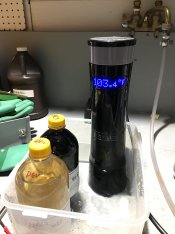Hal Reiser
Member
Got a notice from B&H this morning that E100G is back in stock at $12.99 per roll. I immediately purchased four rolls.
Got a notice from B&H this morning that E100G is back in stock at $12.99 per roll. I immediately purchased four rolls.
Halogen projection bulbs are very close to a daylight source when it comes to projecting an image. No blue necessary.

Not to be a "wet blanket" but one has to wonder -- given that the availability of E6 processing has been plummeting over the years, will this work? I know I have pretty much given up on color film as getting it processed takes too long and costs a lot, especially transparencies. The last roll of 120 Fuji I had done took me three weeks to get back from a small local chain that does it in house but apparently waits until they have a pile to do. I understand that thinking, but I found it discouraging.
None the less, if they are seeing the sales potential to make the move, hey -- go for it!
Does think/know if there is a blue cast added to Ektachrome to compensate for tungsten projection bulbs? I am gearing up to scan slides (old Kodachromes, Ektachromes, Agfa, GAF, etc.) and wonder if this is universal.
Yes, but when you project your image, the projection process gives you accurate colour on the screen.I think halogen is 3000-3400 K, unless projectors use specially balanced ones (maybe with filters?). See this: https://inspectapedia.com/electric/Bulb_Color_Temperatures.php
Halogen bulb...
3,000 oK Other sources rate halogens at 3,400 oK Note 3.
Your eyes adapt! This is virtually unrelated to illumination.
PE
There is no tint added. There is a UV filter in all color films though.
PE
The maximum colour temperature of a halogen bulb is only about 3400K.Halogen projection bulbs are very close to a daylight source when it comes to projecting an image. No blue necessary.
KOdachrome used to often require a different colour filter pack when making duplicate slides I am told. Probably since the dyes are different, they look more different to the duplicating film than they do to the eye.



The specific Kodachrome spectral dye density and Ektachrome spectral sensitivity and resulting dye densities creates the need for filters when making dupes. The analysis is called a print-through. This is a spectral analysis. The characteristics are cascaded to determine the best filter pack. Modifyingthe filter pack doesn't give the best possible dupe from Kodachrome. So Kodak had a special Ektachrome dupe film, Type K that had spectral sensitivity and image dyes to optimize duplication of Kodachrome (K-14) Film on to a E-6 dupe film.
Bob Shanebrook www.makingKODAKfilm.com

| Photrio.com contains affiliate links to products. We may receive a commission for purchases made through these links. To read our full affiliate disclosure statement please click Here. |
PHOTRIO PARTNERS EQUALLY FUNDING OUR COMMUNITY:  |